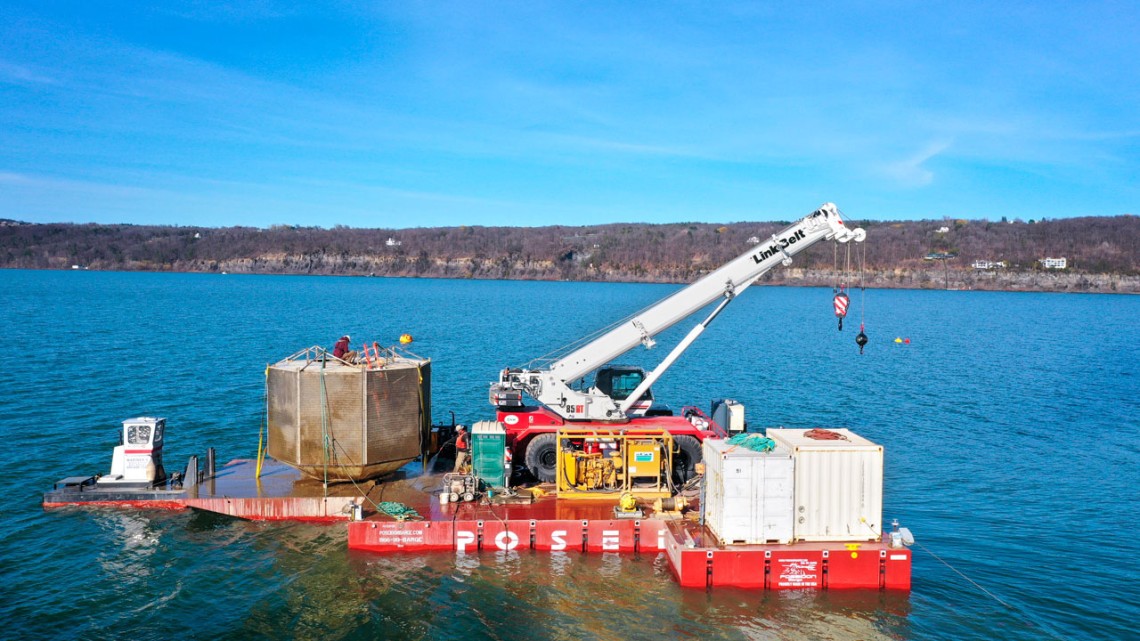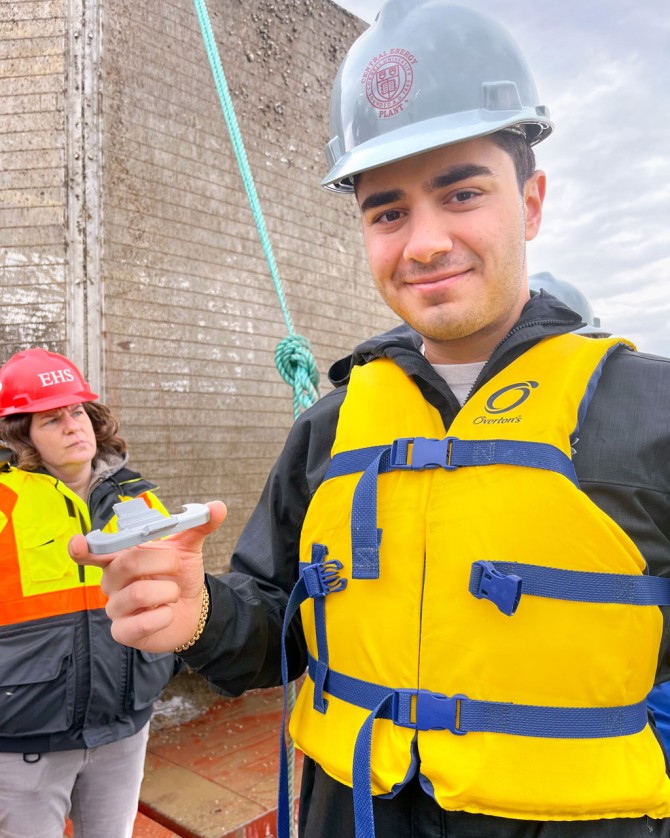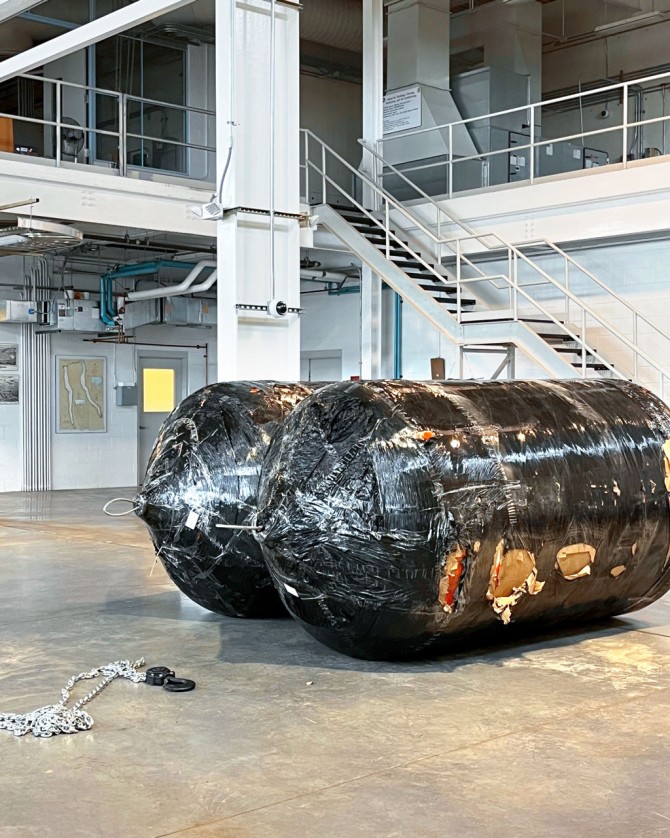
In Cayuga Lake, an octagonal four-ton screen keeps debris out of the pipe that draws lake water for the system that cools the university without commercial refrigerants. As part of a cleaning process, the screen had to be attached to chains and lifted up to a barge to be power washed.
Pigs, mussels and 3D printing keep Lake Source Cooling flowing
By Laura Reiley, Cornell Chronicle
Mark Tarazi ’24 crunched over the gravel at Ithaca’s East Shore Park marina with the new stack of 3D-printed shackle-alignment tabs.
Out in Cayuga Lake, 250 feet down, there was an octagonal 4-ton screen aimed at keeping animal life and debris out of an intake pipe that feeds Cornell’s Lake Source Cooling (LSC) system. Its two metal loops had to be hooked to chains so it could be pulled out of the depths and set down gently on a barge for power washing.
But it was fiddly: A remotely operated vehicle was sent down to attach the two shackles to the screen, but they had to be aligned just so to put a pin through – a bit like operating a robot to thread a needle at the bottom of a murky swimming pool, with kids splashing above.
Cleaning the screen was step 1 of a significant project – a shared effort by Cornell engineers, undergraduates and underwater robots. Cornell’s Lake Source Cooling facility, launched in 2000, uses the icy, deep waters of Cayuga Lake to provide central cooling on campus, a green tech innovation that saves more than 20 million kilowatt-hours of electricity per year over previous cooling methods, without the use of refrigerants. Many refrigerants are potent greenhouse gases that damage the ozone layer.
But the pipes drawing water out of the lake are under siege from exotic invaders: Zebra and quagga mussels colonize the water intake pipes, their tenuous byssal thread “anchors” allowing them to dig in and, over time, restrict water flow. These small non-native bivalves, brought from Europe in the ballast water of ocean-going ships, cause billions of dollars of damage to municipal and private facilities that rely on fresh water.
Tarazi, a mechanical engineering student who manages Cornell’s Rapid Prototyping Lab, was bringing an emergency tweak to the fix he had printed in just a couple hours for a group of engineers. His boss, Matt Ulinski, director of the Master of Engineering Program, came to him April 10 with a thorny problem that required an immediate solution.
Tarazi designed a tab made of an opaque thermoplastic for the shackle to nestle into, so the pin lined up precisely.
It worked. On April 17, he and a small boatful of engineers donned lifejackets and zipped out to the barge to watch the no-longer-submerged screen get scrubbed.
“It’s really cool to see it in action,” Tarazi said from the deck of the barge. “We don’t usually get to see the end project or how our part fits into it. It was really meaningful to see that we’re making a difference.”
The LSC system has allowed the university to bypass industrial chillers, reducing the electricity usage and costs to cool Cornell and Ithaca High School dramatically, according to Stacey Edwards, Cornell Energy Transition program manager. But over a period of years, the pressure at which that cold water coming into the plant’s heat exchangers drops, eventually necessitating intervention.
“We draw water in and send it right back out, so we don’t want to chemically treat it, we have to mechanically clean,” Edwards said, noting pressure loss is not linear, with most loss in the first year after a cleaning (the last cleaning was in 2015). Variables such as drought and the lake level can affect pressure levels dramatically. Earlier this year they recorded diminished pressure and knew it was time to clean.
Edwards grasped for just the right metaphor: It’s like a cork being pushed through a 2-mile hose to gently scrape debris from its interior. Or it’s like swabbing the interior of a 57-inch-diameter goblet with a stale but squishy marshmallow, something just rough enough to effectively do the job.
The swabber/scraper, called a pig, is a cylinder 7½ feet long and 5 feet in diameter, abrasive but not so firm that it wrecks the valves or directional-change elbows along its long path. This month they are sending three pigs in serially to run their 2-mile gauntlet, then they will reinstall the octagonal screen over the intake valve, relocate the barge dockside, and be done with this Roto-Rooter-esque task for some years.
The cost for the whole Lake Source Cooling system, proposed in 1994 and approved 1998, was not cheap. But even at $58.5 million, twice the expenditure of simply replacing the existing electric chillers, Bert Bland, associate vice president for Energy & Sustainability at Cornell, said it has saved the university millions of dollars and reduced fossil fuel dependency.
This mussel-scrubbing project with three pigs will likely cost upward of $750,000, Edwards said. To restore the ideal pressure of 32,000 gallons of cold water per minute, the project has required the expertise of 15 engineers and skilled tradespeople, including Cornell undergraduates and underwater robots, working more than a month.
It’s too early to say whether all that effort yielded a system less “mussel-bound.” Said Edwards: “We won’t know how clean it got until we start running again and track fouling over time.”
Media Contact
Get Cornell news delivered right to your inbox.
Subscribe



